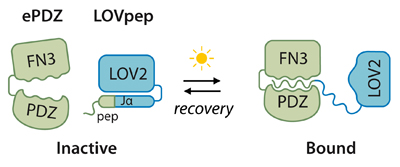March 8, 2012
CBC Catalyst Comes into Bloom: TULIPs
Congratulations to the CBC Catalyst Team: Tobin Sosnick, Eric Weiss and Michael Glotzer for their recent publication in Nature Methods! “TULIPs: tunable, light-controlled interacting protein tags for cell biology” describes development of novel optogenetic tools that can be used to directly manipulate the formation of protein complexes that drive diverse cellular processes.
The project developed as an exciting collaboration between three groups on two Chicago campuses: the Glotzer and Sosnick groups at the University of Chicago and the Weiss group at Northwestern University. The original idea sprung from Devin Strickland’s Ph.D. thesis in the Sosnick lab that showed that the photosensitive LOV2 domain (of Avena sativa phototropin 1) could be used to modulate other protein domains with light. “We realized that many interesting biological processes could be studied from a novel angle if we could regulate a whole host of different proteins with light,” recalled Glotzer. Strickland was intrigued by the idea of controlling important biological processes in cells with light and decided to join the Glotzer lab to take on this challenge.
Making each individual protein light-regulated would require a lot of protein engineering. “We decided to go around this problem and figure out a way to make the interaction between two small proteins light-regulated and then attach other proteins of interest to these two proteins. Formation of light-regulated dimers could then be used to control the localization of specific proteins or the formation of specific protein complexes,” explained Glotzer.

In 2009, Sosnick and Glotzer applied for an NIH Eureka grant to fund this high risk – high reward project. Shortly after they realized that the project could benefit from interactions with Eric Weiss at Northwestern who studies yeast and is experienced in high throughput screening. Eric was excited to participate and the same year the three PIs submitted a CBC Catalyst award application to provide support for high throughput methods and the Weiss lab expertise with yeast. “We were fortunate to get both proposals funded,” said Glotzer. “The collaboration worked very smoothly, we interacted frequently through video-conferences and swapped reagents freely. All of us were excited to see if we could make it work.”
As it turned out, the idea worked beyond expectations. Although TULIPs was mostly developed in the Glotzer lab, the collaboration with Northwestern and hence the possibility to use budding yeast was critical, as it allowed the team to screen many variants quickly. It also allowed them to determine which variants actually worked inside living cells and to demonstrate that this system could control cell growth and polarity. The involvement of the Sosnick biophysics lab was invaluable because understanding of the mechanism by which the LOV2 domain converted light into a conformational change helped to design and optimize the system.
“The CBC project allowed us to take risks that we normally would have taken a pass on, and ended up getting us a tool that will let us do entirely new things,” remarked Weiss. “As an added benefit, it also established a collaborative team that works well together after the funding period ended and has begun spinning off even more new ideas.” Indeed, all three labs still meet frequently and exchange ideas. “We are now using these advances to study new aspects of biology and develop second generation strategies to study cells with light,” concluded Glotzer.
The project hit the spot, fulfilling the CBC’s mission. As Sosnick summarized: “The CBC’s goal of bringing the Chicagoland institutions together was very successful. It motivated us to expand the UChicago collaboration to include Eric Weiss from Northwestern University. Eric brought a new, critical component which helped with the success and direction of our multi-disciplinary project, and will undoubtedly lead to more Chicagoland optogenetic studies.”
Publications attributed to the CBC Catalyst grant:
Strickland D, Lin Y, Wagner E, Hope CM, Zayner J, Antoniou C, Sosnick TR, Weiss EL, Glotzer M. TULIPs: tunable, light-controlled interacting protein tags for cell biology. Nat Methods. 2012 doi:10.1038/nmeth.1904 (Published online 04 March 2012)
Strickland D, Yao X, Gawlak G, Rosen MK, Gardner KH, Sosnick TR. Rationally improving LOV domain-based photoswitches. Nat Methods. 2010 Aug;7(8):623-6. (PubMed)
Collaborators websites: Glotzer Lab, Sosnick Lab, Weiss Lab
Catalyst award: Genetically Encoded Control of Protein Function with Light
CONTACT: Jola Glotzer, CBC Program Manager for the University of Chicago
Phone: 773.834.5132, Email:
SEE ALSO:
